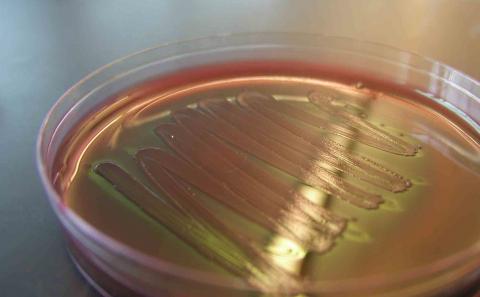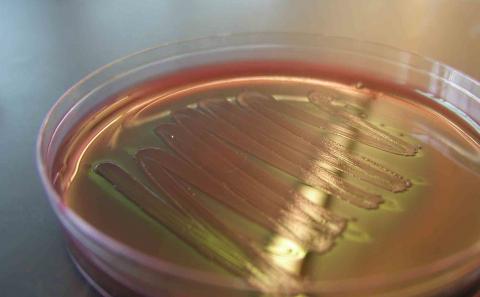
This cysteine-based peroxidase unique to prokaryotes may provide relevant clues for designing novel anti-bacterial therapies.
Redoxoma Highlights by Luis. E. S. Netto
Oxidants play central roles in cell signaling during host-pathogen interactions. Among them, hydroperoxides of arachidonic acid are mediators of inflammatory processes in mammals, whereas hydroperoxides of linoleic acid play equivalent roles in plants. Therefore, hydroperoxide levels are strictly controlled by both hosts and pathogens. CEPID redoxoma is leading the biochemical/structural characterization of bacterial Ohr (Organic Hydroperoxide Resistance Protein), which is an unique Cys-based peroxidase with very distinct features than analogous proteins from host organisms [1, 2, 3].
Recently, we showed that Ohr reduces fatty acid hydroperoxides and peroxynitrite at extremely high rates [4]. Furthermore, bacterial mutants devoid of Ohr gene display high sensitivities to these oxidants, whereas mutant strains deficient for other peroxidases were equally sensitive than wild type cells to fatty acid hydroperoxides. Therefore, Ohr plays central roles in the bacterial response to two hydroperoxides that are at the host–pathogen interface [4]. Ohr enzymes were previously thought to be restricted to prokaryotes, but we found Ohr orthologues also in eukaryotic microorganisms (some pathogenic), many of them located in mitochondria [5].
Our group also described novel findings related to OhrR, which is a transcriptional regulator that represses Ohr expression. We recently showed OhrR also represses diguanylate cyclase expression in Chromobacterium violaceum. Furthermore, deletion of OhrR attenuated the virulence of C. violaceum in mice, decreasing the bacterial burden in the liver [6]. Since Ohr-OhrR system is absent in both mammals and plants, it represents an attractive target for drug development.
References
- J. R. R. Cussiol, T. G. P. Alegria, L. I. Szweda, L. E. S. Netto. Ohr (Organic Hydroperoxide Resistance Protein) Possesses a Previously Undescribed Activity, Lipoyl-dependent Peroxidase Journal of Biological Chemistry, 285(29): 21943–21950, 2010 | doi: 10.1074/jbc.m110.117283
- M. A. Oliveira, B. G. Guimarães, J. R. Cussiol, F. J. Medrano, F. C. Gozzo, L. E. Netto. Structural Insights into Enzyme–Substrate Interaction and Characterization of Enzymatic Intermediates of Organic Hydroperoxide Resistance Protein from Xylella fastidiosa Journal of Molecular Biology, 359(2): 433–445, 2006 | doi: 10.1016/j.jmb.2006.03.054
- E. Piccirillo, T. G. P. Alegria, K. F. Discola, J. R. R. Cussiol, R. M. Domingos, M. A. de Oliveira, L. de Rezende, L. E. S. Netto, A. T. Amaral. Structural insights on the efficient catalysis of hydroperoxide reduction by Ohr: Crystallographic and molecular dynamics approaches PLOS ONE, 13(5): e0196918, 2018 | doi: 10.1371/journal.pone.0196918
- T. G. P. Alegria, D. A. Meireles, J. R. R. Cussiol, M. Hugo, M. Trujillo, M. A. de Oliveira, S. Miyamoto, R. F. Queiroz, N. F. Valadares, R. C. Garratt, et al. et al.. Ohr plays a central role in bacterial responses against fatty acid hydroperoxides and peroxynitrite Proceedings of the National Academy of Sciences, 114(2): E132–E141, 2016 | doi: 10.1073/pnas.1619659114
- D. Meireles, R. Domingos, J. Gaiarsa, E. Ragnoni, R. Bannitz-Fernandes, J. da Silva Neto, R. de Souza, L. Netto. Functional and evolutionary characterization of Ohr proteins in eukaryotes reveals many active homologs among pathogenic fungi Redox Biology, 12: 600–609, 2017 | doi: 10.1016/j.redox.2017.03.026
- M. Previato-Mello, D. de A. Meireles, L. E. S. Netto, J. F. da Silva Neto. Global Transcriptional Response to Organic Hydroperoxide and the Role of OhrR in the Control of Virulence Traits in Chromobacterium violaceum Infection and Immunity, 85(8): , 2017 | doi: 10.1128/iai.00017-17
Luis. E. S. Netto, PhD. Professor at Department of Genetics and Evolutionary Biology,
Institute of Biosciences, University of São Paulo, Brazil
 Post image credits
Post image credits
Add new comment